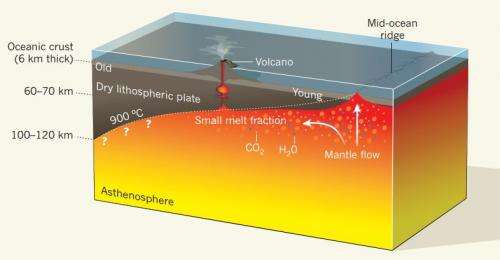May 1, 2014 report
Lab study suggests small layer of water, CO2 and silicate lies beneath tectonic plates

(Phys.org) —A team of researchers working in France is suggesting in a paper they've had published in the journal Nature, that the uppermost part of the asthenosphere consists of a thin layer of water, carbon dioxide and silicate. Lab testing by the team has shown that such a layer could explain virtually all of the real-world testing results found by planet scientists. Bob Evans of Woods Hole Oceanographic Institute sums up the work by the team in a News & Views piece in the same journal issue.
For many years geo-scientists have debated the nature of the asthenosphere—the upper part of the mantle that has contact with the crust. Because crust plates are able to slide around, the reasoning goes, there must be material there that provides a low degree of friction. The debate has narrowed down to two main theories. The first is that the material is wet, the second is that it's molten. Those that insist it's wet, note that subsurface electrical readings are sufficiently high to suggest that a lot of molten material would have to be present—but that much material would seep away. Those that lean towards the molten theory have had trouble coming up with asthenosphere ingredients that would explain what has been measured. In this new effort, it appears the team in France has finally found them.
The researchers noted that silicate is constantly being pushed down from the surface into the mantle where the edges of plates meet, suggesting it's likely a component of the material. They noted also that both water and carbon dioxide are similarly pushed into the mantel. Wondering if that might be all the necessary ingredients, they created a mix of the three ingredients and then subjected the material to conditions (high temperatures and pressure) that are thought to exist just under the earth's plates. Once those conditions were in place, the team found the material to be highly conductive. Extrapolating their results to a model of the Earth, the researchers found that just a very thin layer of the material in the asthenosphere would conform to real-world measurements of electrical conductivity and seismic velocity field observations. At the same time, the layer would be thin enough that it wouldn't disperse.
Because the study is still so new, it's still not clear if what the research team has found will finally settle the asthenosphere debate—but as Evans suggests, the geo-science community now seems well positioned to finally explain surface plate movement.
More information: Electrical conductivity during incipient melting in the oceanic low-velocity zone, Nature 509, 81–85 (01 May 2014) DOI: 10.1038/nature13245
Abstract
The low-viscosity layer in the upper mantle, the asthenosphere, is a requirement for plate tectonics. The seismic low velocities and the high electrical conductivities of the asthenosphere are attributed either to subsolidus, water-related defects in olivine minerals or to a few volume per cent of partial melt, but these two interpretations have two shortcomings. First, the amount of water stored in olivine is not expected to be higher than 50 parts per million owing to partitioning with other mantle phases (including pargasite amphibole at moderate temperatures) and partial melting at high temperatures9. Second, elevated melt volume fractions are impeded by the temperatures prevailing in the asthenosphere, which are too low, and by the melt mobility, which is high and can lead to gravitational segregation. Here we determine the electrical conductivity of carbon-dioxide-rich and water-rich melts, typically produced at the onset of mantle melting. Electrical conductivity increases modestly with moderate amounts of water and carbon dioxide, but it increases drastically once the carbon dioxide content exceeds six weight per cent in the melt. Incipient melts, long-expected to prevail in the asthenosphere, can therefore produce high electrical conductivities there. Taking into account variable degrees of depletion of the mantle in water and carbon dioxide, and their effect on the petrology of incipient melting, we calculated conductivity profiles across the asthenosphere for various tectonic plate ages. Several electrical discontinuities are predicted and match geophysical observations in a consistent petrological and geochemical framework. In moderately aged plates (more than five million years old), incipient melts probably trigger both the seismic low velocities and the high electrical conductivities in the upper part of the asthenosphere, whereas in young plates, where seamount volcanism occurs6, a higher degree of melting is expected.
Journal information: Nature
© 2014 Phys.org





















